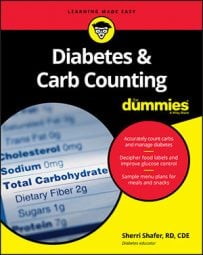Carbohydrate foods are digested into glucose, which is the primary fuel used by your brain and muscles as well as other tissues and organs. You can employ carb counting and portioning tools such as the plate method to assure you get the right amount of carbohydrate to meet your needs.
Your food choices impact more than just your blood-glucose levels; your overall diet affects your quality of life and long-term health. You can enjoy eating while optimizing nutrition. Here are some tips for improving selections within all food groups.
Choosing carbs wisely when you have diabetes
A diagnosis of diabetes doesn’t mean carbs should be avoided or even over-restricted. Carb-containing foods provide important vitamins and minerals. People with diabetes should be mindful of their carbohydrate intakes and choose healthy foods in appropriate portions. Count carbohydrates to ensure your needs are met. Limit sugary foods with added fats and sodium. Opt for nutrient-rich carb choices as indicated here:
- Zero in on whole grains, such as brown rice, oatmeal, quinoa, farro, millet, and bulgur. Look for “whole-grain” breads, pasta, and crackers.
- Count the carbs in your starchy vegetables, such as potatoes, yams, sweet potatoes, corn, and peas.
- Eat plenty of non-starchy vegetables, including broccoli, asparagus, carrots, cabbage, cauliflower, snow peas, mushrooms, tomatoes, and peppers. Load up on leafy green salads. Choose a variety of colorful produce.
- Look for ways to add legumes. Toss kidney or garbanzo beans into salads, dredge raw veggies in hummus, or have a side of beans.
- Forage for fresh fruits. Limit to one serving at a time and skip the juice. Eat portions that are the size of a tennis ball or that fit in a 1-cup measuring cup.
- Choose nonfat, low-fat, and reduced-fat milk and yogurt.
Picking best-bet proteins and fats
Uncontrolled diabetes increases your risk for heart disease. Diabetes has a dietary component to successful management, and the same can be said for heart disease. In terms of diabetes, the focus is on carb quality, portioning, and carb counting. For heart health you’ll want to limit artery-clogging saturated fats and trans fats; instead choose healthier fats from vegetable oils and fish. These tips provide guidance:
- Opt for lean proteins to accompany your carbs. Fish is fantastic, seafood is sensational, poultry is perfect (skinless), tofu is terrific, and there’s even room for red meats (lean, not marbled).
- Protein is also provided in eggs, cheese, cottage cheese, and vegetarian meat replacements.
- Legumes are packed with protein. They also contain soluble fiber, which is the heart-healthy type that helps lower blood-cholesterol levels.
- Use heart-healthy fats and oils, including olive oil, canola or any liquid vegetable oil, nuts, nut butters, seeds, and avocados.
Portioning the perfect plate as you control carbs
For many people with type 2 diabetes, blood-glucose levels can be adequately controlled with simple carbohydrate portioning guidelines. Rather than counting carbs precisely, the plate method offers a quick visual tool for portioning foods. The plate method not only helps manage carb intake, but it can also help with weight control by setting serving size limits. Here’s how it works:
- Fill 1/4 of your dinner plate with grain, bread, or starchy vegetables.
- Reserve 1/4 of the plate for lean protein, then load up 1/2 of the plate with salad or low-carb vegetables.
- Opt for a small serving of fruit and a cup of reduced fat milk if desired.
- Here’s an additional visual check: Keep the protein serving the size of the palm of your own hand and the starch portion the size or your clenched fist.
Making better choices when counting carbs
Managing carb intake is important for everyone with diabetes because carb choices and portions directly affect blood-glucose levels. Your food choices influence more than just diabetes management; what you choose to eat affects your weight and overall health. With a few simple modifications, you can improve the quality of your diet and lower your intake of fat, calories, sugar, and salt. That’s good news for your diabetes, weight, heart health, and blood pressure.
- Instead of: Whole milk, regular cheeses, cream cheese, sour cream
Choose: Nonfat, low-fat, or reduced-fat versions - Instead of: Bacon, sausage, ribs, salami, pastrami, hot dogs
Choose: Canadian bacon, ham, lean roast beef, poultry, veggie dogs - Instead of: White, refined breads, crackers, pastas, rice
Choose: Whole-grain breads, crackers, pastas, brown rice - Instead of: Sweet rolls, breakfast pastries, donuts, Danish, muffins
Choose: Fruit spreads on whole-wheat toast or an English muffin - Instead of: Potato chips, corn chips, buttery popcorn
Choose: Baked versions of chips, air-popped or microwave lite popcorn - Instead of: Deep-frying foods
Choose: Baking, steaming, grilling, poaching, boiling, broiling - Instead of: Regular sugary soft drinks, sodas, sweetened iced tea
Choose: Diet drinks, mineral water, unsweetened (or diet) tea - Instead of: Solid fats such as butter, stick margarine, and shortening
Choose: Liquid vegetable oils such as olive, canola, soybean, sesame, and peanut oils - Instead of: Salt
Choose: Salt-free seasonings, herbs, spices, pepper

